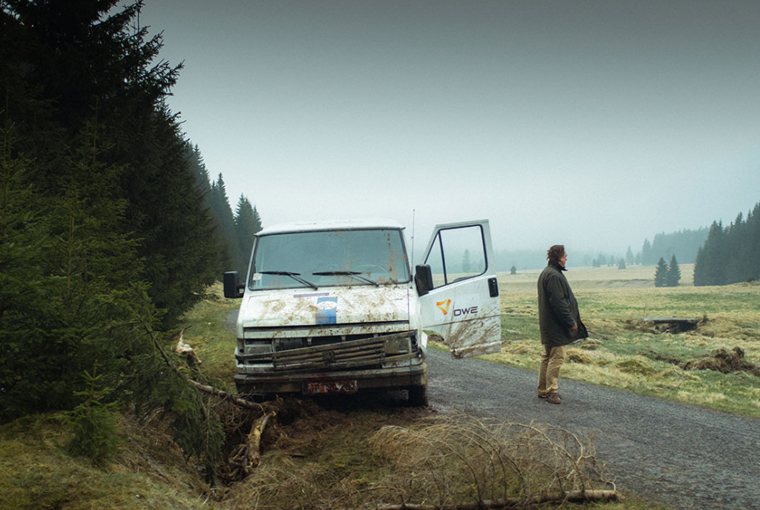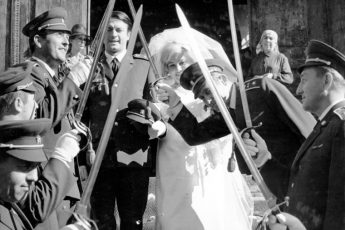All Quiet on the Eastern Front
Štěpán Altrichter’s Schmitke (2014)
Vol. 75 (May 2017) by Konstanty Kuzma
Before 1989 I always found the East dubious, history class in school, behind the curtain of my repressed memories, but now, the Sonnenburger, the Schönhauser, the Kastanienallee, a wonderful gray zone, no longer East, not yet West, just right for putting yourself to the test.”
– Play Zone, Tanja Dückers1
This is how a character from Tanja Dückers’ Play Zone (Spielzone) describes the appeal of 1990s Berlin’s Prenzlauer Berg neighborhood, and by extension the whole of East Berlin, which quickly turned into a magnet for Western intellectuals, artists and partygoers after the fall of the Berlin Wall. Only a decade earlier, because of that very wall, the city’s Eastern part had been a symbol of the FDR’s repressive politics and a popular, if sometimes fatal point of escape. Like Dücker’s teenage protagonists, it was the topographical shadow of that system rather than its body politic that most tourists sought out when flocking to “playgrounds” like Prenzlauer Berg in the 1990s. Inevitably, many newcomers remained ignorant of both the local population’s political struggles against that system before ‘89, and of the gentrification they themselves set in motion.
While large parts of Berlin (certainly of hip neighborhoods such as Mitte, Prenzlauer Berg or Friedrichshain) have by now been Westernized and lost much of their “edge”, a similar pattern of inverted movement from and to the East can now be traced back to the personal stories of many Eastern European filmmakers. For it is the children of emigres who once fled the socio-political realities of the Eastern Bloc who are now returning to their parents’ home countries either physically or through their movie projects. Štěpán Altrichter is one such child, though he and his family only moved to Germany from the Czech Republic (then Czechoslovakia) in the 1990s. In this sense, his family didn’t really flee from the Communist & Socialist East so much as move away once the possibility of “free movement” was given. The fact remains that a career that would have drawn most filmmakers away from Czech Republic before 1989 has led Altrichter back to his roots, and that – more importantly – this is not a pioneering move. What would have seemed counterintuitive to Altrichter’s parents’ generation has become the new normal.
Štěpán Altrichter’s debut movie Schmitke gives us several hints why this is so. The first and most obvious one is that traveling to, say, the Czech Republic with a Western-based movie project turns it into a co-production, opening up new financial possibilities. In this case, a student film that would normally have to build on the modest budget provided by the HFF film school in Potsdam could further draw on money allocated by the Czech film fund. (Another potential source of funding for European co-productions that Altrichter’s film was eligible for are funds dispersed through the MEDIA program, one of the EU’s many cultural diplomacy arms.) Marketing-wise, the foreign element puts the film apart from similar films that must compete for viewers without being able to point to an exotic film setting, a distinguishing feature that can be relevant on the festival circuit as well.
In Schmitke’s case, however, creative reasons may have been more decisive. To anyone familiar with the German film scene, lead actor Peter Kurth’s claim that the project’s “lack of Germanness” made him join it (pro bono, as Alprichter has stressed) will not seem profane. After all, German cinema has been in a creative crisis for the last two decades or so. In spite of occasional glimmers of hope (in recent years Viktoria and Toni Erdmann, both notably reliant on a strong foreign element), this state of disarray has been so persistent that the German association of film critics (VDFK) has recently convened to discuss how it can best be solved. What better way for a young filmmaker to escape this creative crisis than break out of Germany?
Still, neither the economic nor the creative factor explain why directors like Altrichter move to the home countries of their parents rather than say, France or the US. If it is intuitive why Romanian-origin filmmakers would try and jump on the Romanian New Wave train (which they’ve been doing a lot), Czech Republic has not exactly been able to restore its 1960s reputation. Plagued by its own creative crises, it does not seem like the right place to overcome aesthetic fatigue. Why didn’t Alprichter go and make a road movie in Texas? Of course, there is a sense in which he might as well have, but I think that there is more to the rationale of the decision than that. To answer this riddle, we will have to consult a more universal feature of human existence, and with it the film’s story.
To begin with the latter (it is about time), Schmitke revolves around an eponymous engineer who is sent to the Czech Ore Mountains to fix a wind turbine, a gigantic construction which hangs over the forest landscape like a lighthouse (creaking, not shining). The whole story is put in comedic terms with occasional spurts of mystery (not to forget the more personal touch created by Kurth’s persona and the magnificent score) – something, both ancient fairytales and recurrent radio announcements suggest, is out in the forest. While each of these two realms has its characters, with Schmitke’s co-worker Thomas providing for cheap laughs and creepy geologist X provoking roans, Peter Kurth is able to masterfully navigate between both of these disparate worlds. The way the minimalism of his performance contrasts with the grotesque shtick of his sidekicks only minimally accounts for this mastery – the sly subtlety of his character is largely of Kurth’s own making.
Once Thomas disappears and Schmitke is alone out in the open, one thing leads to another. Trying to make his way through the rough mountains and the equally unwelcoming local population, Schmitke (as well as the friendlier viewer) are gradually nudged out of their comfort zone and forced to accept the wearisome, routine reality surrounding him. This is where Alprichter deploys a message of reconciliation rather than catharsis, suggesting that Schmitke must learn to come to terms with his own nature and the world around him. The conclusion is not brought about by way of a plot point, or an epiphany, but over a beer in the local pub which is embraced rather than being shoved away, as seemingly ever-grim Schmitke once used to do.
It is here, in the local pub, that the hidden theme of both Alprichter’s film and his return to Czech Republic become apparent. The question behind both pursuits is “Who am I?” – a quest for one’s own roots which, however problematic, is deeply entrenched in people’s lives, and which can only be overcome by the equally unreal yearning for “Heimatlosigkeit” (lack of home), as Germans would call it. Though I personally feel closer to that last orbit, the way the former question is part of our nature should not be called into question. Nor should it be neglected that Altrichter’s answer to that question is itself a skeptical one – for though he seeks out a particular place to find it, the path he takes is one of disillusionment. In the Ore Mountains, Schmitke does not find ways of solving his problems, but a way of accepting them. To transpose it back on the issue of origin, Alprichter suggests not that home is a place of brilliance, but that it is a place whose hopelessness we have grown accustomed to. While I am wary of the Hegelian, non-interventionist implications this could have, the pessimistic tone of the answer seems about right. Just don’t forget that things are not alright.




Leave a Comment